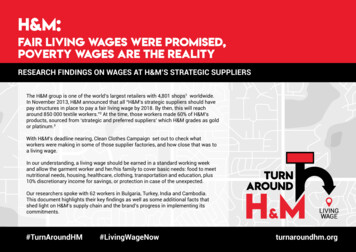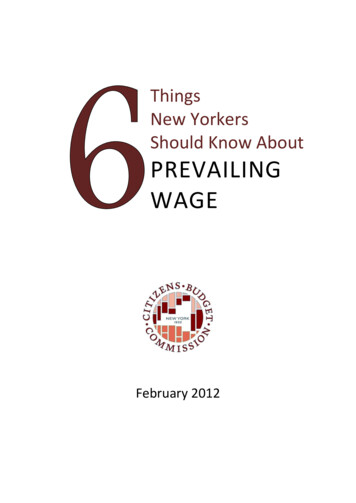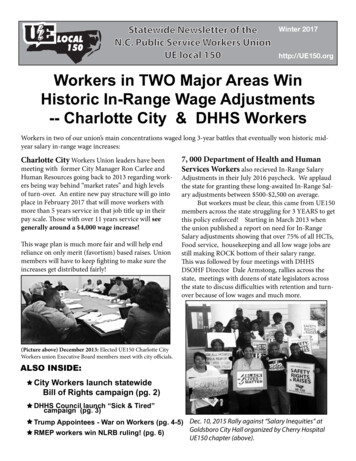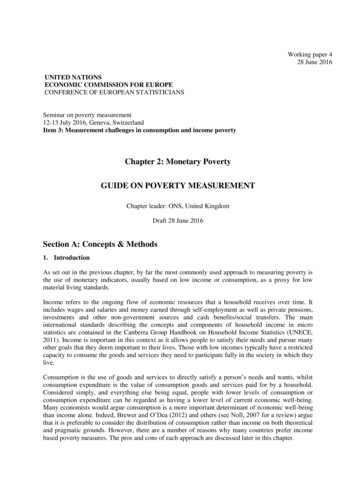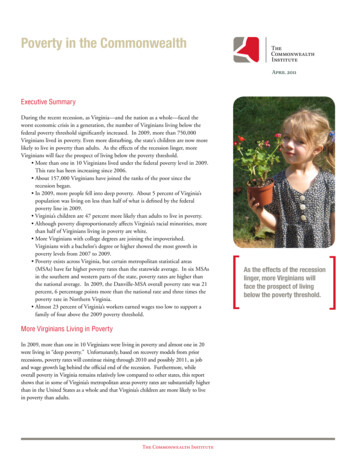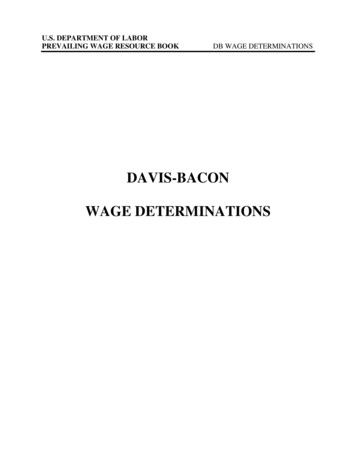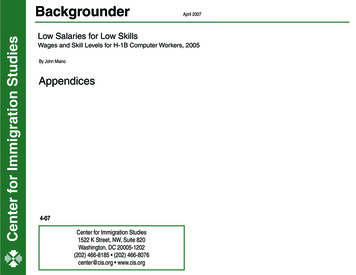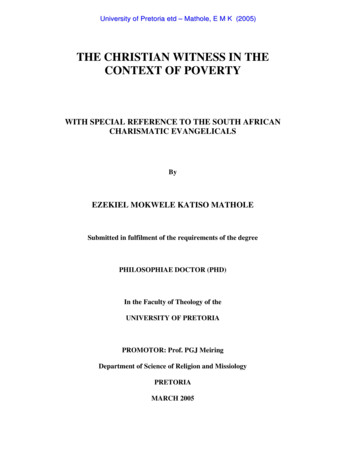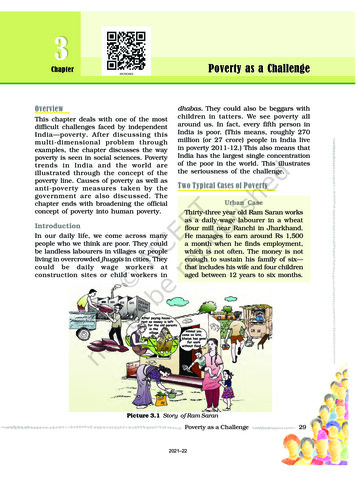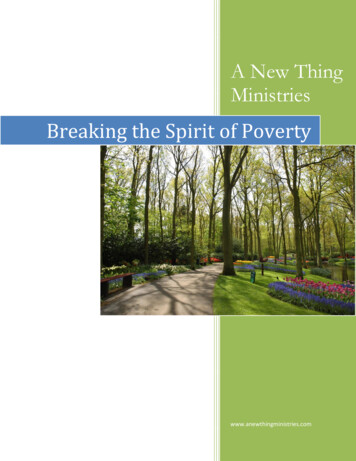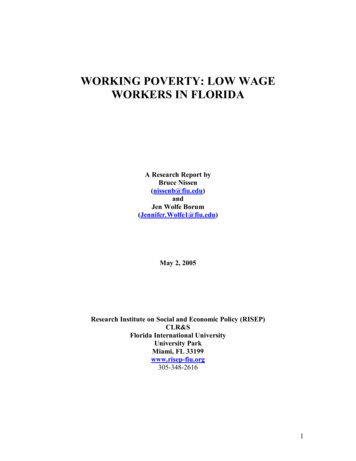
Transcription
WORKING POVERTY: LOW WAGEWORKERS IN FLORIDAA Research Report byBruce Nissen(nissenb@fiu.edu)andJen Wolfe Borum(Jennifer.Wolfe1@fiu.edu)May 2, 2005Research Institute on Social and Economic Policy (RISEP)CLR&SFlorida International UniversityUniversity ParkMiami, FL 33199www.risep-fiu.org305-348-26161
Working Poverty: Low Wage Workers in FloridaExecutive SummaryThis report by the Research Institute of Social and Economic Policy at FloridaInternational University examines the latest US Census information on the working poorin Florida. Florida is a low wage state and many in Florida are working full-time and stillpoor. As detailed below, a significant proportion work full-time and still cannot affordadequate housing, have no access to health care, and have no pensions. Women,minorities, and immigrants are all more likely to work and still not escape poverty.Florida and Low-wage Work Florida has an unusually high percentage of low-wage jobs, due to its tourist-relatedeconomy.Florida also has a higher poverty rate than average for the U.S.“Working poverty” means living in poverty despite full-time year-round work.While poverty and low wages are not synonymous (many in poverty do not work),there is of course a strong connection between the two.This report briefly looks at poverty in the state, and then examines low-wage jobs andthe ability of those who hold them to be “self-sufficient,” meaning ability to supportoneself or one’s family. This is the most meaningful definition of poverty.Poverty Women are more likely to live in poverty than are men.Even more children live in poverty: fully 19% of Florida children lived in officiallydefined poverty in the year 2003Working age population adults are less likely to live in poverty than those above orbelow the age of normal working life.African Americans in Florida have a poverty rate over three times as high as do nonHispanic whites, and Hispanics have a poverty rate over twice as high.Almost a quarter of working age black females live in poverty, as do almost eighteenpercent of Hispanic females, compared to just over ten percent of working age nonHispanic white femalesAlmost ten percent of Florida families are in poverty, andAlmost five percent of married couples are at or below the poverty line.2
Self-Sufficiency and Working PovertyHousing Affordability More than a quarter of all Florida households could not afford adequate housing in2002Well over half of low income households could not afford adequate housing andOver 70% of very low income households could not afford adequate housingThose who rent are much more likely to not be able to afford adequate housing.Virtually all low wage workers, other than those who are dependents, are renters andunable to afford adequate housing.Between 46% and 70% of renter families (depending on family size) in Florida couldnot afford even the smallest appropriate size rental unit with those in the largestfamilies being the least likely to be able to find appropriate, affordable rental housing.A single low-wage worker in Florida earning 8.23 per hour or less could not evenafford an efficiency apartment without a bedroomA couple consisting of low-wage workers with two children could not afford to rentan apartment with a bedroom for each child.Low-wage Workers and Healthcare In 2002 only 55% of private sector establishments in Florida offered health insuranceto employees.Only 42% of Florida employers with fewer than 50 employees offered healthinsuranceAlmost three quarters of all low-wage workers are not provided health insurancecoverage by their employerLow-wage workers are almost never able to afford to purchase health insurancecoverage on their ownLow-wage Workers and Pension Coverage For all workers, Florida has the lowest rate of employer-provided pension coverage ofany state in the nation.Minorities, immigrants, and private sector workers are much less likely to receive apension than are the majority, native-born, or public sector counterparts.Only slightly more than 16% of Florida’s low-wage workers have a private pension.Very Low-wage Workers: Florida and the Minimum Wage Very low-wage workers, those earning 7.15 an hour or less, number approximately695,566 workers, or 9.49% of Florida’s workforce.Very-low wage workers constitute the bottom 9.5% of the Florida wage marketMore women than men are very low-wage workers in the state of Florida3
A significantly higher percent of working minorities in Florida are making a very lowwage in comparison to white non-Hispanic workersImmigrants are more likely to be paid very low wages than are the native-born.Nine out of ten very low-wage workers are employed by private sector employersRetail is overwhelmingly the sector with the lowest wages. Florida’s retail tradesector provided 48.1% of Florida’s jobs paying 6.15 per hour or lessTeenagers do not predominate among very low-wage workers. 76.6% of thoseearning 6.15 per our or less were aged 20 or over, and 81.9% of those earningbetween 6.15 and 7.15 per hour were 20 or over.Conclusion A high number of Florida’s low-wage workers (meaning those earning 8.23 per houror less) exist in poverty, even if they work throughout the year. This situation can belabeled “working poverty.” Women, minorities and immigrants are especially likelyto be low-wage workers, and are the hardest hit by these dynamics. There is a seriouslack of affordable housing for these workers. Three out of four receive no employerprovided health insurance of any type. Fewer than one in six receive a privatepension, meaning they will be entirely dependent on social security income in theirold age.Those working for very low wages (defined as those making 7.15 per hour or less)will benefit from the state’s new minimum wage of 6.15 per hour (indexed upwardannually for inflation). These workers share the same characteristics and problems ofall low-wage workers in the state, but in more accentuated form. They too tend to befemale, minority, and/or immigrant. Housing is even more unaffordable for them.Less than one in five is provided health insurance of any type by their employer, andless than one in six is provided any pension. The 500 to 2,000 more per year theseworkers are likely to receive as a result of the state’s new minimum wage is animportant step forward for these workers. But the state and the state’s low-wageemployers need to do a lot more for these workers on all fronts: income, housing,healthcare, and pensions.4
Working Poverty: Low-wage Workers in FloridaFlorida has always had a high proportion of low-wage workers compared to other states.This is related to the state economy’s reliance on tourism-related employment and lowwage service employment relating to the needs of retirees. This preponderance of lowwage employment has numerous negative consequences for the state, among themproblems of poverty and its many related ills (health problems, crime problems, etc.)This report will profile the low-wage workforce in the state of Florida using the latestdata from the U.S. Census. It has a particular interest in the issue of working poverty,meaning those in poverty despite the presence of at least one wage earner who works fulltime throughout the year.In this report we first examine the poverty status of individuals and families, and look atthe wages that would be required to pull them out of poverty. Following that, we turn ourattention to individual low-wage workers irrespective of the poverty status of theirfamilies. Low wages and poverty are not identical. Some low-wage workers reside inmiddle- or even high-income families, and some workers supporting a family on a singlewage a little above the “low-wage” cut-off point reside in families that are in poverty, forexample. Further, a number of families in poverty have no one working, or no oneworking full time. Despite the lack of a one-to-one correspondence between low-wageand working poverty status, there obviously is a very large overlap. Finally, we look atthe housing, health care, and pension coverage status of Florida’s low-wage workers.PovertyFlorida has a higher percentage of its population in poverty than does the United States asa whole; it can be considered a moderately high poverty level state. According to theAmerican Community Survey, in 2003 its poverty rate was 13.1% compared to the12.7% U.S. average, placing the state 21st highest of the 50 states in this category.Table 1 shows poverty rates for a wide variety of categories of Florida residents.Table 1Florida Poverty Statistics for Individuals, 2003 (based on family income in the past12 months)FloridaAllAge 16-64(Working age population)Males age 16-64Females age 16-64Children age 15 and underTotalPopulationPopulation below poverty 9,506733,781663,34110.04%13.90%19.48%Source: American Community Survey, Census web site5
Table 1 demonstrates that women are more likely to live in poverty than are men. Evenmore children live in poverty: almost one in five Florida children lived in officiallydefined poverty in the year 2003. Table 1 also reveals that working age population adultsare less likely to live in poverty than those above or below the age of normal workinglife.Table 2 shows that poverty is unevenly distributed among Florida’s population. AfricanAmericans and Hispanics have higher poverty rates than do non-Hispanic whites, andAfrican American and Hispanic females have particularly high rates of poverty.Table 2Florida Poverty Statistics for Different Races and Ethnicities, 2003 (based on familyincome in the past 12 months)FloridaWhite non-HispanicWhite age 16-64White 16-64 maleWhite 16-64 femaleBlack/African AmericanBlack age 16-64Black 16-64 maleBlack 16-64 femaleHispanicHispanic age 16-64Hispanic 16-64 maleHispanic 16-64 ,054,0521,040,2521,013,800Population below poverty 17.75%15.22%12.76%17.75%Source: Authors’ analysis of various American Community Survey tablesTable 2 shows that African Americans in Florida have a poverty rate over three times ashigh as do non-Hispanic whites, and Hispanics have a poverty rate over twice as high.Within the working age population, the disparities are not quite as extreme, but theyremain very large. Almost a quarter of working age black females live in poverty, as doalmost eighteen percent of Hispanic females, compared to just over ten percent ofworking age non-Hispanic white females, for example.Chart 1 provides a visual summary of the differences between different races andethnicities in rates of poverty, as related in Table 2.6
Chart 1Percent of the Population Below Poverty Level forDifferent Races and Ethnicities in Florida, 200330%25%All20%Age 16-6415%Age 16-64 Male10%Age 16-64 Female5%0%White nonHispanicBlack/AfricanAmericanHispanicTable 3 shows the poverty status of Florida’s families, with a family defined as two ormore people living together who are related to each other. Almost ten percent of Floridafamilies are in poverty, and almost five percent of married couples are at or below thepoverty line. Three things stand out from the table: (1) the importance of full time work;(2) the significantly higher poverty rates of households headed by a single parent; and (3)the significantly worse situation for women than for men.7
Table 3Florida Poverty Statistics for Families*, 2003 (based on family income in the past 12months)FloridaTotalPopulationPopulation belowpoverty levelAllMarried-couple familyAt least one spouse worked full-time**Male householder, no wife presentLone male householder, worked fulltime**Lone male householder, worked less 19%15.37%176,8488,3214.71%73,11215,77821.58%Female householder, no husband presentLone female householder, worked fulltime**Lone female householder, worked lessthan 45,75993,89438.21%Source: Authors’ analysis of various American Community Survey tables* A family consists of a householder and one or more other people living in the same household who arerelated to the householder.** Assumes worked year-roundOne major problem with the “official” definition of poverty is that it is unrealisticallylow. The Federal government defines “poverty” as three times the cost of feeding afamily on a very stringent food budget, even though food today is closer to 1/6th of afamily’s budget than it is to 1/3rd. A much more realistic measure of poverty isapproximately double the “official” standard. The Federal government understands thatthis is true. In fact, the U.S. Census Bureau (2004) states about the federal poverty levelthat “Although the thresholds in some sense reflect families’ needs, they are intended foruse as a statistical yardstick, not as a complete description of what people and familiesneed to live.” Many federal and local programs such as Supplemental Security Income,Medicaid, and Section 8 low-income housing assistance do not use the federal definitionof poverty in determining eligibility, but instead use a multiple, such as 1 ½ times, or 2times the official poverty level.Self-Sufficiency and Working PovertyBy far the most realistic standard of what constitutes “real” poverty would ask whatincome would be required to survive at normal rents, food and transportation costs, etc.,without any form of public or private “welfare” assistance. Such a standard has beencompiled for Florida – it is known as the “self-sufficiency standard.” The selfsufficiency standard was developed as a means to measure, based on family size, age of8
children where applicable, and location (counties or selected areas within counties), howmuch a family must earn to afford housing, transportation, food, child care, health care,and other essentials without the assistance of public or private entities. The standardassumes that children and adults do not share a bedroom and that there are no more thantwo children in one bedroom. As this standard does not consider savings, Pearce andBrooks (2002) clearly explain that self-sufficiency wages are wages necessary only tomaintain a decent standard of living. Table 4 gives examples of self-sufficiency wages inFlorida.Table 4Self-Sufficiency Wages*, Florida 2004Lowest countyHighest countyWeighted Averagefor the state**Adult 6.65 (Graceville,Jackson County) 10.07(Monroe County) 8.552 adults preschooler school age childTwo wages of 7.93 per hour(Sumter County)Two wages of 11.68 per hour(Monroe County)Two wages of 10.10 per hourFamily TypeSource: Pearce and Brooks; The Self-Sufficiency Standard for Florida, Sept. 2002* Self-sufficiency wages updated to reflect December 2004 Consumer Price Index** Weighted averages are the authors’ computations from data in Pearce and Brooks.In most cases, the self-sufficiency standard for Florida is approximately twice that of thefederal poverty thresholds for similar family types. For example, in 2004, the povertythreshold for a family consisting of two adults and two children under the age of 18 was 19,157; however, according to the self-sufficiency standard in 2004, the annual wageneeded for a working family consisting of two adults, one infant, and one preschoolerwas 33,226 (close to double) in Jefferson County, Florida and 50,963 (more than 2 ½times) in Broward County, Florida,1 respectively the lowest and highest self-sufficiencystandards for this family type in Florida. (For more details, and for a listing of selfsufficiency wages in all areas of the state, see Pearce and Brooks, listed in the Sources atthe end of this report.)Working poverty refers to those who work full time year round and still exist in poverty.If the more realistic self-sufficiency standard of poverty is used to determine poverty, ingeneral an unmarried adult in the state (regardless of whether he or she had children ornot) who made below the 8.55 per hour would be considered part of the working poor.Similarly, if neither partner of a married couple with two wage earners with two children(one pre-school and one school age) made less than 10.10 per hour, they would beconsidered part of the category of working poverty. As we shall see shortly, anycommonly-used definition of low-wage worker puts a low-wage worker in Florida beloweither 8.55 or 10.10 per hour. Thus, virtually the only low-wage workers in the statewho are not in working poverty are those who are dependents of others making moremoney or in multiple earner families with few children, not those attempting to supporteither themselves or a family of any size. We now examine low-wage workers inFlorida.9
Low-wage Workers in FloridaOne of the typical ways to define what qualifies as “low-wage” is to choose the 20thpercentile wage, which is the wage at which 20 percent of the working populationmakes less and 80 percent of the working population makes more. Our analysis of theCurrent Population Study (CPS) indicates that the 20th percentile wage in Florida for2004 was 8.23 per hour.2 Thus, our beginning definition for low-wage workers is thosewho make below the 20th percentile wage, or 8.23 per hour.What are the characteristics of Florida’s low-wage workers? We first look to see whichgroups are overrepresented among low-wage workers. The following three tables showwho is most likely to receive low wages. Table 5 shows differences between males andfemales. Table 6 shows differences between racial and ethnic minorities and the majoritypopulation. Table 7 shows difference between immigrants and the native-born. Eachtable also shows whether the differences found are statistically significant (meaning thatwith 95% confidence we can say that these differences are not the result of mere chance,given that we are working with samples.)Low-wage workers and gender differences. With respect to gender, females areoverrepresented among low-wage workers as seen in table 5.Table 5Statistical Differences in Low-Wage Workers by Gender, Florida 2002-2004MalePercent who are low-wageworkers (Below 8.23 perhour)Female16.56% 23.39%DifferenceStatistically significant6.8%YesSource: Authors’ analysis of CPS data, 2002-2004. Significance is at the 95% level of confidence.Clearly, more women than men are low-wage workers in the state of Florida. Almost aquarter of women workers earn wages below the 20th percentile.Low-wage workers and Racial/Ethnic differences. With respect to racial/ethnic groups,black non-Hispanics and Hispanics are heavily overrepresented in the low-wage categorycompared to white non-Hispanics. Table 6 shows the difference.Table 6Statistical Differences in Low-Wage Workers by Race/Ethnicity, Florida 2002-2004% Below 8.23 per% Difference fromStatisticallyhourWhite non-HispanicssignificantWhite non-Hispanics15.81%0%NABlack Source: Authors’ analysis of CPS data, 2002-2004. Significance is at the 95% level of confidence.10
A significantly higher percent of working minorities in Florida are making a low wage incomparison to white non-Hispanic workers. The percent of black and Hispanic workersmaking a low wage almost doubles that of white-non-Hispanic workers.Low-wage workers and Immigration status. Immigrants are also much more likely to bepaid low wages than are the native-born. Table 7 shows the difference.Table 7Statistical Differences in Low-Wage Workers by Foreign Born Status, Florida 20022004% Below 8.23 per% Difference fromStatisticallyhourNative Born WorkerssignificantNative Born16.94%0%NAForeign Born30.14%13.2%YesSource: Authors’ analysis of CPS data, 2002-2004. Significance is at the 95% level of confidence. For thepurposes of this analysis, Puerto Ricans are considered “foreign born” even though Puerto Rico is a U.S.colony, because they more closely share characteristics with immigrants.The percentage of immigrants who are low-wage earning is over 30%, almost doublethat of native-born workers.Economic sector of low-wage workers. Do low-wage workers tend to work in the privatesector, or the public sector? Table 8 looks at the differences between the two sectors todetermine if there are significant differences in their percentage of low-wage workers.Table 8Statistical Differences in Low-Wage Florida Workers by Sector, 2002-2004Government Private Difference SignificantPercent who are low-wage workers12.33%21.15%-8.8%Yes(Below 8.23 per hour)Source: Authors’ analysis of CPS data, 2002-2004. Significance is at the 95% level of confidence. Data isfrom answers to questions about the previous week in the March CPS survey of that year.Private sector workers are much more likely to receive low wages than are public sectorworkers. Since approximately 85% of the working population in Florida works in theprivate sector, we estimate that approximately 90% of low-wage workers in the statework in the private sector. Within the private sector, the industries that have extremelylarge numbers of low-wage workers are the leisure and hospitality industry, the retailtrade industry, and many types of service industries.Chart 2 provides a visual summary of the differences by gender, racial and ethnic status,immigrant status, and economic sector group in the percentage of low-wage workersfrom the data contained in Tables 5 through 8.11
Chart 2Percent of Workers Making Below 8.23 per Hour in ge Workers and Housing AffordabilityIt is well established that individuals and families should not be spending more than 30%of their income on housing. Housing costs higher than 30% of income mean that thehousing is not affordable, since 70% of an individual or family’s budget is required forother necessities. Thus, low income workers need either very inexpensive housing, orthey need higher incomes, or they need both.In dealing with housing affordability, we are dealing with incomes, not merely wages.For example, a family or household may have income from sources other than wages.However, low-wage families are not very likely to derive any income from investments,so the bulk of their income is either in wages or various types of “welfare” paymentsfrom public and private sources. If we leave aside public (or private) assistance income(welfare), it is safe to roughly equate incomes and wages for these low-wage families.What kind of wage is required for individuals, and for various sizes of households inFlorida? A full time wage of 8.23 per hour would leave 428 per month in thebudget for rent or a mortgage payment, at 30% of the budget. Housing costs ofcourse vary from locality to locality, and it is useful to look at the “average,” in additionto using measures that adjust for differences in housing costs from locale to locale.A household can be said to be “cost burdened” in housing costs if those housing costsamount to more than 30% of the household income. This is simply a technical way tosay that households that are unable to afford the housing needed, given the size ofthe household. Table 9 shows that more than a quarter of Florida households were cost12
burdened in housing costs in 2002, but well over half of low income households were inthe same period, and over 70% of very low income households were.Table 9Household Cost Burden: Percentage of Income Spent on Housing by HouseholdType, Florida 2002Cost Burdened* inHouseholdsHousing CostsNumber of% of AllNumber of% ofHouseholds Households Households HouseholdsFloridaAll Households6,588,0921,848,31628.06%Renter Households1,960,82429.76%821,25841.88%Owner HouseholdsLow-Income**Households (varies byarea, but on avg., 41,947or less income)Extremely Low-Income***Households (varies byarea, but on avg., 15,730or less 0%1,408,83254.83%708,45910.75%496,60070.10%Source: Authors’ analysis of Florida Housing Data Clearinghouse (FHDC) data estimates found html* Cost Burdened is defined as a household that spends 30% or more of their income on housing costs**Low income is reported household income equal to 80% or less of the Area Median Income (AMI).AMI is median family income calculated annually by the Department of Housing and Urban Development(HUD) for Metropolitan Statistical Areas, counties or non-metropolitan areas, with adjustments for familysize and for areas that have unusually high or low income to housing cost relationships. AMI is used todetermine eligibility for federally and locally funded programs. In the state of Florida in 2002 the averageAMI was 52,434 per year. Eighty percent of 52,434 is 41,947 per year.***Extremely low income is reported household income less than or equal to 30% of the Area MedianIncome, which in 2002 would average 15,730 per year in the state of Florida. .Table 9 shows that more than half of those households making an income less than what 20.17 per hour would earn for full-time work year-round are “cost burdened”, or unableto afford appropriate housing. Thus, a low-wage worker earning less than 8.23 per hourwould be extremely likely to be “cost burdened” unless there were multiple wage earnersin the household, and even in that case the odds are still pretty good that this would be thecase.A second thing to note from Table 9 is that renter households are much more likely tobe unable to find housing at less than 30% of income (i.e., to be “cost burdened”) than areowner households (42% vs. 22%). Virtually all low-wage workers other than thosewho are dependents are renters rather than house owners, simply because they cannotafford the down payment on even the least expensive house. This is an additional13
indication that low-wage workers have an extremely difficult time finding affordablehousing.Chart 3 provides a visual summary of the differences by household type in thepercentages of households that are cost burdened, from the data in Table 9.Chart 3Cost Burdened Households in Florida, 2002100%80%60%Affordable Housing CostsCost ouseholdsFair Market Rents (FMRs) are calculated annually by the U.S. Department of Housingand Urban Development (HUD) and are used to determine whether families are eligiblefor federal housing assistance. The rental amounts include the cost of rent and utilitiesand are dependent upon the distribution of current rental prices (usually set at the 40thpercentile and sometimes the 50th percentile), location, and number of bedrooms. FMRsare calculated for metropolitan and non-metropolitan areas.Can a typical Florida low-wage worker afford an apartment at Fair Market Rental rates?Table 10 shows that large percentages of renters were unable to afford appropriate sizedapartments in 2002, and of course the percentages would be even higher if only low-wageindividuals and their families were included in the figures.14
Table 10Estimated Percent of Renter Families* Unable to Afford** Fair Market Rent(FMR) by Family Size, Florida 2002Number of familyZeroOneTwoThreeFourmembersBedrooms Bedroom Bedrooms Bedrooms ter than 434.03%39.36%48.99%62.58%69.54%Source: Authors’ analysis of Integrated Public Use Microdata Series (IPUMS), ACS 2003* A family consists of a householder and one or more other people living in the same household who arerelated to the householder.**A unit is considered affordable if it costs no more than 30% of the renter's family income.Table 10 shows that between 46% and 70% of renter families in Florida could notafford even the smallest appropriate size rental unit (efficiency for an individual; onebedroom for two family members; two bedrooms for three family members; threebedrooms for four family members, etc.) in 2002. Note the percentages in bold to see thepercentage at each size family unit.Updating to 2004, have things improved? Are low-wage workers and their families morelikely to be able to afford appropriate living accommodations? The National LowIncome Housing Coalition annually calculates a housing wage which is the amount aperson who works work full-time must earn in order to afford a two bedroom rental unit(based on the current FMR) such that no more than 30% of his or her income goestowards the cost of the rental unit. Table 11 shows the 2004 Fair Market Rent (FMR)cost in Florida of different size apartments, and the income needed to rent at FMR rates.Table 11Florida Fair Market Rents by Number of Bedrooms, and Income Needed to AffordFair Market Rents*, 2004ZeroOneTwoThreeFourBedrooms Bedroom Bedrooms Bedrooms BedroomsMonthly Fair Market Rent 601 674 799 1,052 1,222(FMR)Annual Income needed to 24,036 26,965 31,967 42,067 48,862rent at FMRSource: National Low Income Housing Coalition, 2004*A unit is considered affordable if it costs no more than 30% of the renter's income.Table 12 shows the hourly wage needed to rent in Florida at Fair Market Rates in 2004,also known as the “housing wage.”15
Table 12Florida Housing Wage, 2004Hourly Wage Needed to Afford Fair Market Rent (FMR)(working 40 hours per week)Zero Bedrooms One Bedroom Two Bedrooms Three Bedrooms Four BedroomsFMRFMRFMRFMRFMR 11.56 12.96 15.37 20.22 23.49Source: National Low Income Housing Coalition, 2004It is apparent from Table 12 that a single low-wage worker in Florida earning 8.23per hour or less could not even afford an efficiency apartment without a bedroom,on average
any state in the nation. Minorities, immigrants, and private sector workers are much less likely to receive a pension than are the majority, native-born, or public sector counterparts. Only slightly more than 16% of Florida's low-wage workers have a private pension. Very Low-wage Workers: Florida and the Minimum Wage
